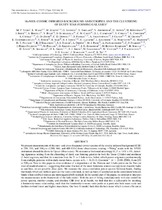Hermes: Cosmic infrared background anisotropies and the clustering of dusty star-forming galaxies

View/
Date
2013Author
Viero, M. P.
Wang, L.
Zemcov, M.
Addison, G.
Amblard, A.
Arumugam, V.
Aussel, H.
Bethermin, M.
Bock, J.
Boselli, A.
Buat, V.
Burgarella, D.
Casey, C.M.
Clements, D.L.
Conley, A.
Conversi, L.
Cooray, Asantha
de Zotti, G.
Dowell, C.D.
Farrah, D.
Franceschini, Alberto
Glenn, J.
Griffin, M.
Hatziminaoglou, Evanthia
Heinis, S.
Ibar, Edo
Ivison, R.J.
Lagache, G.
Levenson, L.
Marchetti, L.
Marsden, G.
Nguyen, H.T.
OHalloran, B.
Oliver, S.J.
Omont, A.
Page, Matthew J.
Papageorgiou, A.
Pearson, C.P.
Perez-Fournon, I.
Pohlen, M.
Rigopoulou, D.
Roseboom, I.G.
Rowan-Robinson, M.
Schulz, B.
Scott, Douglas
Seymour, N.
Shupe, D.L.
Smith, A.J.
Symeonidis, Myrto
Vaccari, M.
Valtchanov, I.
Vieira, J.D.
Wardlow, Julie L.
Xu, C.K.
Metadata
Show full item recordAbstract
Star formation is well traced by dust, which absorbs the
UV/optical light produced by young stars in actively starforming
regions and re-emits the energy in the far-infrared/
submillimeter (FIR/submm; e.g., Savage & Mathis 1979).
Roughly half of all starlight ever produced has been reprocessed
by dusty star-forming galaxies (DSFGs; e.g., Hauser & Dwek
2001; Dole et al. 2006), and this emission is responsible
for the ubiquitous cosmic infrared background (CIB; Puget
et al. 1996; Fixsen et al. 1998). The mechanisms responsible
for the presence or absence of star formation are partially
dependent on the local environment (e.g., major mergers:
Narayanan et al. 2010; condensation or cold accretion: Dekel
et al. 2009, photoionization heating, supernovae, active galactic
nuclei, and virial shocks: Birnboim & Dekel 2003; Granato
et al. 2004; Bower et al. 2006). Thus, the specifics of the
galaxy distribution—which can be determined statistically to
high precision by measuring their clustering properties—inform
the relationship of star formation and dark matter density, and
are valuable inputs for models of galaxy formation. However,
measuring the clustering of DSFGs has historically proven
difficult to do.
